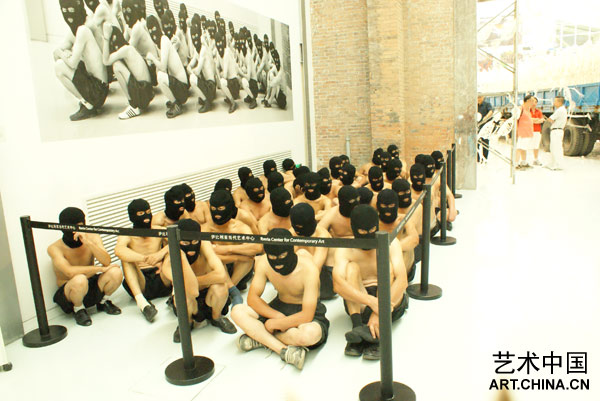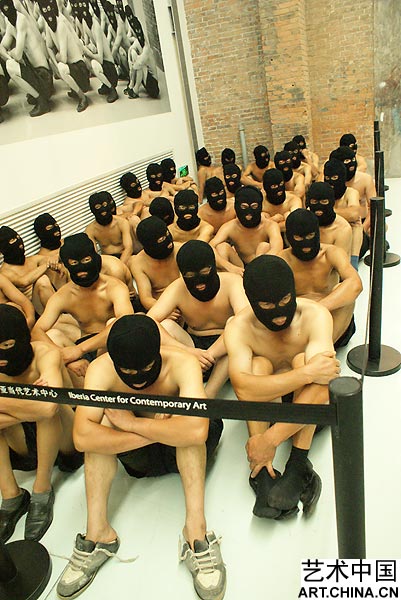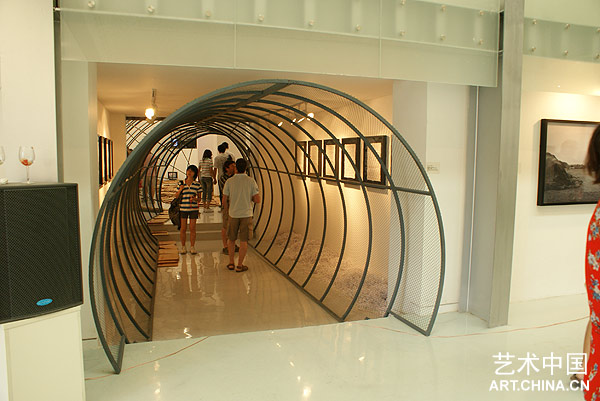|
Microscopic Narration: Social Images by Zhang Xiaotao and Li Yifan
“Microscopic Narration: Social Images by Zhang Xiaotao and Li Yifan” is a thematic exhibition composed by two solos—Mist and Dossier, featuring respectively two artists Zhang Xiaotao and Li Yifan. The exhibition title “Microscopic Narration” presents the homogenous aspect of their art practice. Zhang Xiaotao is frequently exhibited as a painter while Li Yifan works as a documentary director. Though working with different mediums, both of them have been devoted to textual research and narration of Chinese modern reality. In recent years Zhang Xiaotao has been experimenting on cross-media and interdisciplinary concepts while employing microscopic perspective and symbolic visual images to foreground the anxiety and restlessness embedded inside Chinese society that is undergoing a major transformation. His work thus is shrouded in an intensely religious atmosphere. On the other hand, Li Yifan undertakes field surveys and draws visual samples from the underclass of Chinese society, unveils the realistic and spiritual facets of an existence in Chinese bottom society. The two solo shows Mist and Dossier are co-referential, constructing a complementation at both content and narrative levels.
In this current exhibition, the dualist oppositional nature of the microscopic and macroscopic has been further dispelled in Zhang Xiaotao’s works. He has categorized the inspiration for these works as some kind of connection in his life and memories that he is constantly perceiving: from the massive, heavy shadows of Chongqing Steel factory complex to the “cultural zoo” that is 798 and on to the absurd and extravagant Windows to the World theme park, a theme of “dream factory and rubbish heap” begins to float to the surface. Though there is no direct link in these scenes, Zhang Xiaotao says that “there is an obscure thread in my mind that absurdly links them together”. Following along the logic of the microscopic narrative he has been exploring, he wants to use a “sampling” method to rethink the “nature of collective modern ideals in pre-socialist China and the painful price paid and hard lessons learned”. Under this overarching theme he has proposed a series of questions, including “what still survives from our socialist heritage? What has already died? What structural change have we gotten from the transition period? How do we attain affirmation and translation of our identity amidst the progression of globalization? How do we enter into the complex, multiple viewpoint structure of economics, politics and culture of a truly “harmonious society” from the disordered state of the transitional period?” What we see in these grand and heavy questions is an extremely macroscopic theoretical field of view, but the response Zhang Xiaotao gives us as an artist is to, through the identity of a director, create a dream theatre of the microscopic animal world – he “will attempt to use the eyes of animals to observe and visually analyze the spatiotemporal spiritual connections and continuity between Chongqing Iron & Steel and Windows to the World, and the drastic and rapid social change we have encountered in an instantaneous spatiotemporal shift.”

The “pathological research” of which Li Yifan speaks and Zhang Xiaotao’s concept of a “microscopic narrative”, which run parallel to each other, provide us with a critical link for understanding the connections between the two artists. In contrast to clinical diagnosis and treatment, pathology uses information about human disease information, animal tests and other similar microscopic experiment material – such as cultivation of cell colonies – to research the cause, mechanisms, pathological and functional changes in organism and tissue to explain the essence of the illness and the patterns of the illness. So one could say that it is a science that uses microscopic phenomena to understand and intervene in the macroscopic world. In the same manner, beginning with Before the Flood, Li Yifan has focused his work on research and analysis of the “cell colonies” at the fundamental level of Chinese society. In his own words, Before the Flood is “an investigation into the price paid by the middle and lower levels of society in the process of realizing modernization” while Village Archive “probes into the root of bottom rungs of society”. It is worth noting, that as with Zhang Xiaotao, Li’s microscopic research is not about simply deconstructing the grand narrative. He says, “I don’t want to startle and surprise, and I don’t want to simply deconstruct society; I hope to construct a new method of recognition of the lower rungs of society and exploration of current society.”

This penchant was already clearly expressed in Before the Flood. This documentary film included extremely close and detailed coverage of certain individual cases – such as the demolition and relocation process of a church – but what the entire film depicts is the big picture of change among the lives of millions of common people in the process of executing the Three Gorges Dam. This confluence of the microscopic and macroscopic gained a much more defined narrative structure in Village Archive Li Yifan has taken his observations and documentation of the lives, labors and religious activities of the residents of Longwangcun, in Fengjie, Sichuan, and compiled them into a “calendar” that spans the entire year, which turns the existence of these lowly people into an inseparable component of the “natural change of the seasons”. His current works for this exhibition reveal much more complex conceptions of “narrative”. As I see it, the four components that these works make up ontologically comprise three “platforms of artistic representation”. The first platform is “archives”, a narrative that is enacted through the compilation, classification and displacement of existing objects (including materials such as legal documents, files and photos). The second platform is “materials”, which is comprised of documentary film segments and scattered photographs. Unlike “archives”, these materials intentionally document the artist’s participation in the representation process. The third platform can be called “works”, which includes three documentary films (Before the Flood, Village Archive and Sleeplessness and Insomnia) as well as a series of photos staged in a documentary style, entitled Tyrants and the Tyrannized. According to Li Yifan, the compilation of these different images and materials “emphasizes a decoding of the lower rungs of society against the backdrop of contemporary political morality, emphasizes that the use of multiple perspectives and depth are equally important to decoding, and strives to pick apart and criticize the brilliant and dazzling elitist decoding methods through deconstruction via a simple textual method.

From the above it can be seen that the concept of the “microscopic narrative” can cover various meanings. It can be the subject of artistic representation, as with Zhang Xiaotao’s microscopic animal world and Li Yifan’s mundane lower rungs of society. It can be the observational perspective, looking back on life and history through the eyes of a beetle or an unemployed migrant in the city. It can be the storytelling method and the once ignored and obscured secrets it reveals. It can also be the path the artist uses to affirm his identity, using this kind of narrative to consult and interact with the art world and the critical world. Zhang Xiaotao once said that he has been searching for the origin of life through psychology, individual experiences and individual perspectives since 2002. His painting method will never again begin by establishing a grand narrative framework, then follow by finding grounds for an argument and finish by adding bricks and tiles. Instead, it unfolds from individual value. The result is that “language multiplies like so many cells, and once it reaches a certain size, it grows into an individual method and linguistic system.” Li Yifan hopes to “shatter my original identity as a documentary filmmaker, and turn the documentary films I once made under that identity into fragmented materials for a new text.” With these descriptions as reference for the exhibition, I believe that the viewer will be able to understand their artistic pursuits and experiments.
|

